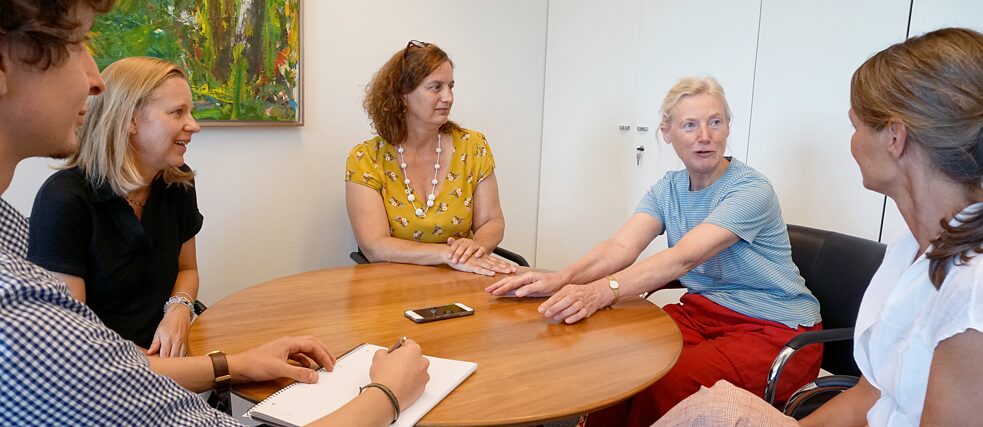Teaching online
“There’s a lot of positive feedback!”

From the classroom to online teaching: The pandemic has ushered in new ways of teaching | © Adobe Stock
“For us teachers, teaching online means full concentration from the first to the last minute. It’s even more strenuous than in-person teaching!” How has the everyday work of teachers changed in the wake of the pandemic? Three Goethe-Institut teachers report their experiences.
By Tobias Brockhorst and Imke Mohr
“Just give learning German a try!”
Marianna Charitou, Dorothee Moser and Annette Walsh teach German at the Goethe-Institut and, since 2020, in online language courses provided by Goethe-Instituts in Germany.Online teaching has achieved one thing in particular that’s obvious to all three of them: “We’re seeing participants in our online courses that we didn’t see in in-person courses.” Distance learners take advantage of the inherent flexibility of mobile access to the language courses.
The makeup of the course participants is even more international than in in-person courses, which have always been very diverse at the Goethe-Instituts in Germany. This simply makes the classes interesting, says Dorothee Moser. Many learners simply wanted to “give learning German a try”, the teachers say, to invest some time in learning German (again), so they went ahead and booked one of the easily accessible online language courses. As a result, their reasons for learning German varied more widely than before. “Learning German online is not a makeshift solution, as it seemed when the pandemic first broke out. Learning languages online has become perfectly normal for a large proportion of learners.”
“Learning German for one’s pleasure?”
The teachers also agree that online language courses in which self-learning phases alternate with virtual learning with a teacher and a group class, i.e. in which synchronous and asynchronous learning are closely coordinated, demand a high degree of autonomy on the part of learners. The teachers often help them adjust to online learning the first time around, explains Marianna Charitou: They have to get their bearings in the virtual classroom, learn how to use the digital tools and get through the self-learning phases by regularly and consistently applying themselves. Actually, not everyone has the requisite language learning competence. For some people, on the other hand, observes Annette Walsh, the high degree of independence required for online language courses reinforces the phenomenon of “learning for their pleasure”: Participants often set one-sided learning priorities in areas or learning activities they particularly enjoy, sometimes neglecting other skills or types of tasks as a result. So, teachers have to closely supervise the online self-learning phases and counteract the pleasure-driven impulses by tutoring in order to encourage participants to try doing less pleasurable tasks as well and make the most of the whole range of learning material.“Many learners don’t compose their texts in the foreign language anymore – that’s too much effort. They have them translated.”
One clearly noticeable side-effect of the increased use of digital tools is the influence of online translation tools, which learners use in remote and even in-person learning. Many of the texts that learners draft at home, contribute to group assignments or hand in for proofreading are clearly machine-translated, observes Annette Walsh. If nothing is done about this now widespread practice, it could ultimately hinder the development of their ability to write in German and consequently make the writing process, which is all about producing language in a particularly conscious manner, less effective. One way German language teachers can react productively to this trend is to actually work with these machine-translated texts in class and correct them or adapt the style thereof to the respective communication situation. Tasks like these can be a way to develop learners’ linguisitic sensibilities and show them what to look out for when using translation software.“Teachers thrive on physical interaction in the classroom!”
“Interaction”, with all its many facets, runs like a common thread through our conversation with the three teachers. The relationship between teacher and learner is direct and dynamic in in-person teaching, says Dorothee Moser. Surveys of language course participants show that this rapport is important for learning: learners generally give in-person teachers top marks. The learners’ attention, which is so essential for learning and often kindled simply by the intensive existing relationship between teachers and learners in in-person teaching, has to be continually reactivated in online teaching: by addressing participants directly, asking them to switch on the camera, doing interactive exercises, etc.The relationship between learners and their teacher is much more distant in online language learning. While we really do hear from in-person learners again after the end of the course, reports Marianna Charitou, this doesn’t happen in online language courses. The role of the online teacher corresponds more to that of a “learning coach” who provides support for increasingly independent learners and assistance in their learning processes.
Also, adds Annette Walsh, online course members develop mutual empathy only gradually as they gain experience in online learning, which is an argument for investing sufficient time in helping the class get to know one another and planning group tasks that lead to a jointly produced result, which can then be used as material to work on together. Cooperation during group work in breakout rooms, in which the whole class is divided up into smaller groups, follows similar principles as in group work in in-person instruction: learners need to be convinced that interaction is actually conducive to helping them learn German – only then will they benefit from group work, whether in-person or online.
 German teachers Marianne Charitou (2nd from left), Annette Walsh (3rd from left) and Dorothee Moser (2nd from right) interviewed by Imke Mohr (far right) and Tobias Brockhorst (far left).
| © Elisabeth Höbel
“Sitting in” on online language courses, one can’t help noticing that live sessions in an online language course are tightly planned, with only a certain number of minutes allotted for each learning activity. But opportunities for personal interaction ought to be actively sought as well, allowing time for conversations that aren’t solely about learning German. We know this from other forms of collective and collaborative online work as well. Whether this has to do with online learning per se or with the lesser importance attached to the social dimension of working or being together virtually remains an open question. In any case, a sense of social cohesion needs to be actively nurtured in online teaching.
German teachers Marianne Charitou (2nd from left), Annette Walsh (3rd from left) and Dorothee Moser (2nd from right) interviewed by Imke Mohr (far right) and Tobias Brockhorst (far left).
| © Elisabeth Höbel
“Sitting in” on online language courses, one can’t help noticing that live sessions in an online language course are tightly planned, with only a certain number of minutes allotted for each learning activity. But opportunities for personal interaction ought to be actively sought as well, allowing time for conversations that aren’t solely about learning German. We know this from other forms of collective and collaborative online work as well. Whether this has to do with online learning per se or with the lesser importance attached to the social dimension of working or being together virtually remains an open question. In any case, a sense of social cohesion needs to be actively nurtured in online teaching.The three teachers are unanimous in finding group teaching in the classroom both gratifying and effective. On the other hand, there’s no doubt in their minds that online language teaching is here to stay – and bound to change their role from teacher to learning coach.
Over the past two years, Goethe-Instituts around the world have considerably expanded their online language-learning programmes and adapted the courses to the differing needs of learners globally. In the online group courses of the Goethe-Instituts in Germany, which is the focus of this article, learners spend half their time in virtual group classes, and the other half learning independently, doing exercises supervised by a teacher on the Goethe-Institut’s learning platform. In these self-learning sessions, they work on linguistic structures and group assignments, and they practise grammatical structures and skills task-based. The teacher gives feedback, corrects written assignments, answers questions about the learning materials provided and encourages the participants. The online group sessions are primarily about group interaction in German.